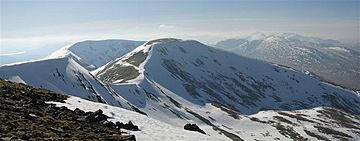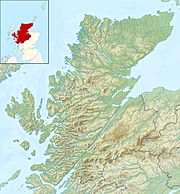Aonach Beag (Ben Alder) facts for kids
Quick facts for kids Aonach Beag |
|
|---|---|

Aonach Beag (centre) with Beinn Eibhinn to the left and Ben Nevis in the far distance on the right
|
|
| Highest point | |
| Elevation | 1,116 m (3,661 ft) |
| Prominence | 99 m (325 ft) |
| Parent peak | Geal-Charn |
| Listing | Munro, Murdo |
| Naming | |
| English translation | Little ridge |
| Language of name | Gaelic |
| Pronunciation | English approximation: oon-ƏKH-bek |
| Geography | |
| Parent range | Grampian Mountains |
| OS grid | NN458742 |
| Topo map | OS Landranger 42 |
Aonach Beag is a tall mountain in the Scottish Highlands of Scotland. It stands 1,116 meters (about 3,661 feet) high. You can find it in a quiet, remote area between two lochs, Loch Ericht and Loch Laggan. It's about 4 kilometers (2.5 miles) northwest of another mountain called Ben Alder.
The name "Aonach Beag" comes from Gaelic and means "little ridge." This might sound a bit funny because it's actually a very big mountain! Aonach Beag is known as a Munro. There is another famous mountain with the same name near Ben Nevis, but this Aonach Beag is different and about 30 kilometers (18.6 miles) to the east.
Contents
Aonach Beag: A Scottish Mountain
Aonach Beag is part of the Grampian Mountains range. It is a significant peak in the Scottish Highlands. Its highest point is 1,116 meters above sea level.
What is a Munro?
In Scotland, a "Munro" is a mountain that is over 3,000 feet (914.4 meters) tall. These mountains are named after Sir Hugh Munro, who first listed them. Climbing all the Munros is a popular challenge for hikers. Aonach Beag is one of these impressive peaks.
Where is Aonach Beag Located?
This Aonach Beag is found in a remote part of the Highlands. It's in an area with many hills that stretch between Loch Ossian and Loch Pattack. The mountain itself has three ridges that meet at its summit. Its neighbor to the west is Beinn Eibhinn, which is slightly lower but covers a larger area.
Exploring the Mountain
Getting to Aonach Beag usually means a long walk. One common way to start is from Corrour railway station. From there, you would walk past the Loch Ossian youth hostel. Then, you follow the southern shore of Loch Ossian. After passing Corrour Lodge, the path goes up a place called Bealach Dubh, following the Uisge Labhair river.
Special Nature Area
Aonach Beag is part of a special protected area. This area is called the Ben Alder and Aonach Beag Special Area of Conservation. It's important because it has unique natural features.
- Acidic Scree: This means there are slopes covered in small, broken rocks that are acidic.
- Alpine Grasslands: These are grassy areas found in high mountain regions.
- Rare Plants: You can find special plants near the summit. These include the three-leaved rush, hare's-foot sedge, and scorched alpine sedge.
- Bryophytes: The area is also known for its many types of bryophytes. These are small, simple plants like mosses and liverworts. They thrive here because of the long periods of snow cover.
This protected status helps keep the mountain's unique environment safe.


